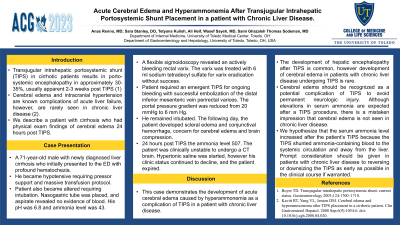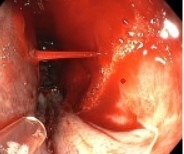Tuesday Poster Session
Category: Liver
P3896 - Acute Cerebral Edema and Hyperammonemia After Transjugular Intrahepatic Portosystemic Shunt Placement in a Patient With Chronic Liver Disease
Tuesday, October 24, 2023
10:30 AM - 4:00 PM PT
Location: Exhibit Hall

Has Audio

Anas Renno, MD
University of Toledo
Toledo, OH
Presenting Author(s)
Award: Presidential Poster Award
Anas Renno, MD1, Sara Stanley, DO1, Megan Karrick, DO1, Tetyana Kulish, 2, Ali Heif, 3, Wasef Sayeh, MD1, Sami Ghazaleh, MD1, Thomas Sodeman, MD4
1University of Toledo, Toledo, OH; 2Wayne State University, Detroit, MI; 3St. John’s Jesuit High School, Toledo, OH; 4University of Toledo Medical Center, Toledo, OH
Introduction: Transjugular intrahepatic portosystemic shunt (TIPS) in cirrhotic patients results in porto-systemic encephalopathy in approximately 30-35%, usually apparent 2-3 weeks post TIPS. Cerebral edema and intracranial hypertension are known complications of acute liver failure, however are rarely seen in chronic liver disease. We describe a patient with cirrhosis who had physical exam findings of cerebral edema 24 hours post TIPS.
Case Description/Methods: A 71-year-old male with newly diagnosed liver cirrhosis who initially presented to the ED with profound hematochezia. He became hypotensive requiring pressor support and massive transfusion protocol. Patient also became altered requiring intubation. Nasogastric tube was placed, and aspirate revealed no evidence of blood. His pH was 6.8 and ammonia level was 43. A flexible sigmoidoscopy revealed an actively bleeding rectal varix. The varix was treated with 6 ml sodium tetradecyl sulfate for varix eradication without success (Fig. 1). Patient required an emergent TIPS for ongoing bleeding with successful embolization of the distal inferior mesenteric vein perirectal varices. The portal pressure gradient was reduced from 20 mmHg to 6 mm Hg. He remained intubated. The following day, the patient developed scleral edema and conjunctival hemorrhage, concern for cerebral edema and brain compression. 24 hours post TIPS the ammonia level 507. The patient was clinically unstable to undergo a CT brain. Hypertonic saline was started, however his clinic status continued to decline, and the patient expired.
Discussion: This case demonstrates the development of acute cerebral edema caused by hyperammonemia as a complication of TIPS in a patient with chronic liver disease. The development of hepatic encephalopathy after TIPS is common, however development of cerebral edema in patients with chronic liver disease undergoing TIPS is rare. Cerebral edema should be recognized as a potential complication of TIPS to avoid permanent neurologic injury. Although elevations in serum ammonia are expected after a TIPS procedure, there is a mistaken impression that cerebral edema is not seen in chronic liver disease. We hypothesize that the serum ammonia level increased after the patient’s TIPS because the TIPS shunted ammonia-containing blood to the systemic circulation and away from the liver. Prompt consideration should be given to reversing or downsizing the TIPS as early as possible in the clinical course if warranted.

Disclosures:
Anas Renno, MD1, Sara Stanley, DO1, Megan Karrick, DO1, Tetyana Kulish, 2, Ali Heif, 3, Wasef Sayeh, MD1, Sami Ghazaleh, MD1, Thomas Sodeman, MD4. P3896 - Acute Cerebral Edema and Hyperammonemia After Transjugular Intrahepatic Portosystemic Shunt Placement in a Patient With Chronic Liver Disease, ACG 2023 Annual Scientific Meeting Abstracts. Vancouver, BC, Canada: American College of Gastroenterology.
Anas Renno, MD1, Sara Stanley, DO1, Megan Karrick, DO1, Tetyana Kulish, 2, Ali Heif, 3, Wasef Sayeh, MD1, Sami Ghazaleh, MD1, Thomas Sodeman, MD4
1University of Toledo, Toledo, OH; 2Wayne State University, Detroit, MI; 3St. John’s Jesuit High School, Toledo, OH; 4University of Toledo Medical Center, Toledo, OH
Introduction: Transjugular intrahepatic portosystemic shunt (TIPS) in cirrhotic patients results in porto-systemic encephalopathy in approximately 30-35%, usually apparent 2-3 weeks post TIPS. Cerebral edema and intracranial hypertension are known complications of acute liver failure, however are rarely seen in chronic liver disease. We describe a patient with cirrhosis who had physical exam findings of cerebral edema 24 hours post TIPS.
Case Description/Methods: A 71-year-old male with newly diagnosed liver cirrhosis who initially presented to the ED with profound hematochezia. He became hypotensive requiring pressor support and massive transfusion protocol. Patient also became altered requiring intubation. Nasogastric tube was placed, and aspirate revealed no evidence of blood. His pH was 6.8 and ammonia level was 43. A flexible sigmoidoscopy revealed an actively bleeding rectal varix. The varix was treated with 6 ml sodium tetradecyl sulfate for varix eradication without success (Fig. 1). Patient required an emergent TIPS for ongoing bleeding with successful embolization of the distal inferior mesenteric vein perirectal varices. The portal pressure gradient was reduced from 20 mmHg to 6 mm Hg. He remained intubated. The following day, the patient developed scleral edema and conjunctival hemorrhage, concern for cerebral edema and brain compression. 24 hours post TIPS the ammonia level 507. The patient was clinically unstable to undergo a CT brain. Hypertonic saline was started, however his clinic status continued to decline, and the patient expired.
Discussion: This case demonstrates the development of acute cerebral edema caused by hyperammonemia as a complication of TIPS in a patient with chronic liver disease. The development of hepatic encephalopathy after TIPS is common, however development of cerebral edema in patients with chronic liver disease undergoing TIPS is rare. Cerebral edema should be recognized as a potential complication of TIPS to avoid permanent neurologic injury. Although elevations in serum ammonia are expected after a TIPS procedure, there is a mistaken impression that cerebral edema is not seen in chronic liver disease. We hypothesize that the serum ammonia level increased after the patient’s TIPS because the TIPS shunted ammonia-containing blood to the systemic circulation and away from the liver. Prompt consideration should be given to reversing or downsizing the TIPS as early as possible in the clinical course if warranted.

Figure: Bleeding rectal varix
Disclosures:
Anas Renno indicated no relevant financial relationships.
Sara Stanley indicated no relevant financial relationships.
Megan Karrick indicated no relevant financial relationships.
Tetyana Kulish indicated no relevant financial relationships.
Ali Heif indicated no relevant financial relationships.
Wasef Sayeh indicated no relevant financial relationships.
Sami Ghazaleh indicated no relevant financial relationships.
Thomas Sodeman indicated no relevant financial relationships.
Anas Renno, MD1, Sara Stanley, DO1, Megan Karrick, DO1, Tetyana Kulish, 2, Ali Heif, 3, Wasef Sayeh, MD1, Sami Ghazaleh, MD1, Thomas Sodeman, MD4. P3896 - Acute Cerebral Edema and Hyperammonemia After Transjugular Intrahepatic Portosystemic Shunt Placement in a Patient With Chronic Liver Disease, ACG 2023 Annual Scientific Meeting Abstracts. Vancouver, BC, Canada: American College of Gastroenterology.

